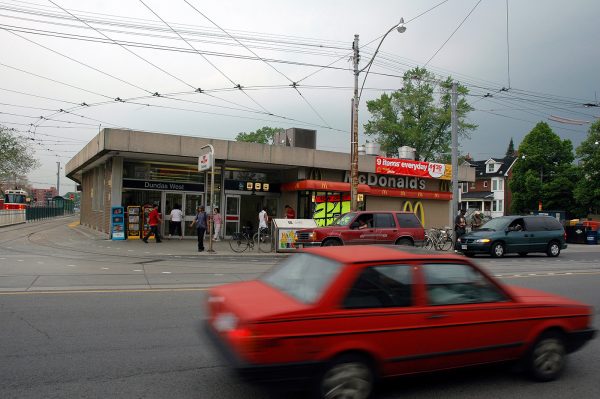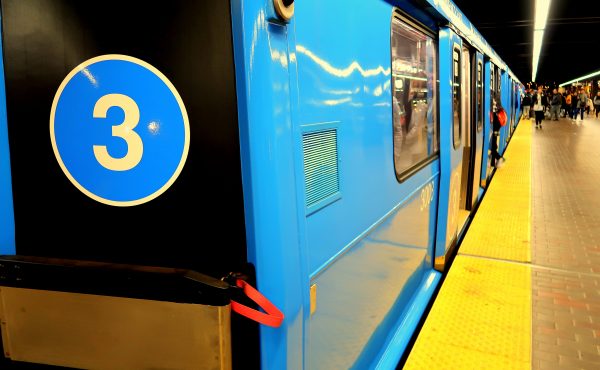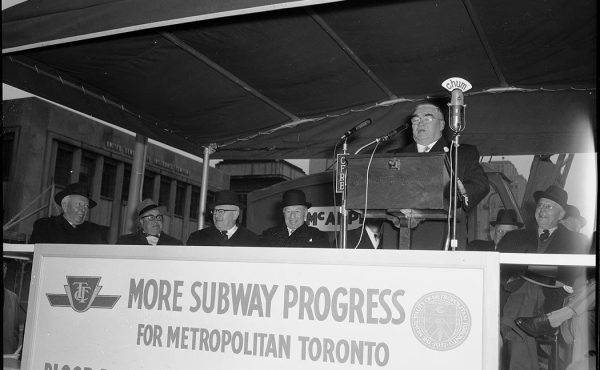All the hype and posturing that accompanied this weekend’s subway opening effectively obliterated a bit of news about a small transit infrastructure project that will almost certainly be a game-changer, provided local and provincial authorities can, well, connect the dots.
In recent months, Metrolinx notified the new owners of The Crossways, the looming apartment complex at the south-east corner of Bloor and Dundas West, that it will expropriate space under the building for a tunnel connecting the Bloor West GO/UPExpress platform and the Dundas West subway station. (The previous owners for years resisted requests to build such a connection.)
At the same time, Metrolinx is preparing to put out an RFP for contractors interested in building a second tunnel and an elevator at the Randolph Ave. cul de sac, which dead ends on the east side of that GO/UP Express (UPE) station. That entrance will provide residents living in the Junction Triangle with convenient access to both stations, something for which they’ve fought for years.
When the tunnels are completed in two years, Metrolinx will have created a living, breathing transit interchange between GO/UPE and the TTC – something that doesn’t exist anywhere else on the system except at Union Station and Kennedy. The tunnel, Metrolinx officials say, will cost about $23 million, or about three quarters of one percent of the amount spent on the Toronto York Spadina Subway Extension. (Correction: There is a tunnel linking the Milton GO line and the Bloor-Danforth subway at the Kipling station, and a direct subway-to-GO transfer between the TYSSE and the Barrie GO at Downsview Park station will open soon.)
In effect, that interchange, when combined with UPE’s current service and Metrolinx’s eventual plans to for all-day/two way trains on major corridors, could become the western half of the relief line, thus relieving the mounting pressure at Yonge/Bloor and St. George/Bloor, both of which are rapidly near capacity.
Will commuters heading downtown from points west make the switch? That long-sought interior connection – so common in most large cities with extensive rapid transit networks and intermodal stations – is a necessary condition, but is it sufficient?
Metrolinx, in recent months, has begun promoting a bundling deal that will give Metropass holders with Presto cards a discount, allowing them to transfer to an UPE train heading downtown for just $1.50 extra.
When Metrolinx adjusted prices on UPE in the months after the service launched in 2015, commuters quickly responded – an acknowledgment that the initial cost-recovery business model for UPE was mostly magical thinking and didn’t reflect the reality that rapid transit in the vast majority of big cities is not a profitable enterprise. It seems reasonable to predict that many commuters will also respond to this enticement, and do so in growing numbers once those linking tunnels are finished.
Yet the fact that Torontonians have to pay a premium to dodge a worsening bottleneck created by years of political inaction serves as another reminder that the region is still light years from figuring out how to properly integrate transit service and thus maximize the gains that networks confer on residents, the environment and, yes, drivers, who benefit from increased transit usage.
How does the Toronto-York Spadina Subway Extension (TYSSE) figure in this west end tunneling tale? It’s true this line will mainly serve York University students and faculty, coming from both the north and the south, in the near term. But as more commuters in the city’s north-west suburbs, as well as those living in Vaughan, opt to take the subway downtown instead of a car or a GO train, the St. George interchange will become increasingly clogged, making a western relief route that much more important.
There’s an indirect but looming cost element here, too – one that is almost certain to become a pain point for Toronto council in years to come. The TYSSE was built with capital dollars provided by the City of Toronto, York Region, and Queen’s Park. But it is owned and operated by the TTC, which means Toronto residents are on the hook for that portion of the operating shortfall associated with running trains into Vaughan/York Region.
About a quarter of the TTC’s annual operating revenues come from taxes levied by the City of Toronto on property owners, businesses, etc. If live in York Region and plan to ride the TYSSE, Toronto taxpayers will be subsidizing your ride – a classic externality. And if 905ers decide they like commuting to work on this new line in large numbers, Toronto residents who board south of Steeles will get a second hit, in the form of jammed rush hour trains with no seats and, eventually, no space (it’s quite common now for commuters at stations like Lawrence and Eglinton to watch stuffed southbound trains go by during peak period).
These are the logical consequences of always building line extensions instead of expanding and strengthening the network, and there’s no evidence I can see that the political classes have truly absorbed this fundamental lesson about transportation planning (the professional planners working at both levels certainly do). Indeed, Patrick Brown’s Tories are heading into next June’s provincial election all but pledging to sink $5 billion into the Yonge North subway to Richmond Hill – an utterly ridiculous project that will effectively strangle the system, absent major investments in network diffusion.
In this light, Metrolinx’s GO/UPE/Dundas West tunnels — and that $1.50 premium fare — are work-arounds – necessary (and welcome) measures that treat the symptoms, but not the disease.






20 comments
“When the tunnels are completed in two years, Metrolinx will have created a living, breathing transit interchange between GO/UPE and the TTC – something that doesn’t exist anywhere else on the system except at Union Station and Kennedy.”
There is also a direct tunnelled connection between the Milton GO line and the Bloor-Danforth line at Kipling Station, and there will be a direct subway to GO transfer between the TYSSE and the Barrie GO line by the end of this month (at Downsview Park station).
Just a correction — as per the report to the TTC Board (http://www.ttc.ca/About_the_TTC/Commission_reports_and_information/Commission_meetings/2017/October_16/Reports/15_Advancing_Fare_Integration.pdf), a PRESTO e-purse user gets a $1.50 *discount* on the $5.30 UPX fare from Bloor to Union.
Basically in either direction: $3.00 TTC Fare + $5.30 UPX Fare – $1.50 discount = $6.80 total
A customer with a TTC Metropass on their PRESTO card is not eligible for the discount.
Err, error on my correction —
$3.00 TTC PRESTO Fare + $4.71 UPX PRESTO Fare – $1.50 discount = $6.21 total
And lest we forget, the Main/Danforth Hub, which still has no workable link between TTC and GO. As it is, GO isn’t relieving any stress on the Danforth TTC (try to get on a morning westbound subway at Main).
If the Main St Hub is to work, it will need to be the most appealing 1-block walk in the city; enough to drag Scarborough subway riders out of their comfy seats and out into the cold to catch a GO train downtown.
The Crossways is on the north-east corner, not the south-east.
I seriously question the potential ridership increase that may take place after this tunnel opens. I just don’t see it. How many people will get off the TTC walk all that distance wait and then take the Go/UP to Union and vice-versa? Few and far between.
In the other direction why would anyone get off the TTC subway to take UP when you can stay on to Kipling and get a very frequent TTC Rocket bus at no additional fare? Zero.
The main thing holding passengers back from the GO-subway connection or GO/UP-subway is probably less to do with the fare and more to do with the GO service frequency. People know what their time is worth. A 10 minute transfer perception plus the actual waiting time … by the time the GO/UP train arrives you could be much further away via subway … is probably a major deal breaker.
I suspect that this is why GO-subway connections at Kipling & Kennedy may be working better than at Bloor GO & Danforth GO. At the end of the line GO is the only rail out of the city, and coming in the subway trip is long enough that transferring to GO makes sense.
There is also no option to use the Milton Line for a quick hop from Kipling to Bloor GO/Dundas West because there is no stop in the line. Stouffville line trains are stopping at Danforth GO but few people are making a subway connection.
What a terrific article! I was beginning to become hopeless that someone could actually spell out the consequences of the ridiculous actions (or inactions depending on which debacle you want to discuss) that are destined for transit in this city.
I’ve visited 12 different countries on 4 continents and lived in 2 countries in a few major cities, and for some reason, Canada seems baffled on how to build sustainable and efficient transit. *knocks head – just can’t seem to get it!
Is it planning transit that’s the problem, or is it certain city officials figuring out how come up with ways to enrich developers pockets – with the expectations that land transfer taxes and property taxes et al. will help fund their next debacle.
Transit is supposed to be primarily for the citizens, but it’s clear it’s actually being built for business instead.
“If live in York Region and plan to ride the TYSSE, Toronto taxpayers will be subsidizing your ride – a classic externality. ”
That sounds like whining. How many billions has Toronto received over the years from the rest of the province for public transit, without belly aching.
A low-cost contribution to solving the congestion at St. George would be to re-install the moving sidewalk between the two Spadina subway stations. I never change there because of the long walk; it’s easier and takes only a couple of seconds longer to stay on the train and transfer at St.George.
“How many billions has Toronto received over the years from the rest of the province for public transit, without belly aching.”
Glen: to answer your question, very little considering Toronto puts way more into the coffers of the province than it gets back. That’s not whining on Toronto’s part, it’s the reality.
Metrolinx also needs to rationalize their GO train station names to match the much busier TTC subway names:
Danforth GO needs to become Main Street,
Bloor GO needs to be renamed Dundas West.
These misnomers are confusing for riders, especially new ones, and travellers to the city.
I’m glad to see Metrolinx actually got it right at Union Station, Kipling, and Downsview Park!
The GTHA rapid transit network also needs a GO station on the Barrie line to interchange with Bloor Line 2 at Lansdowne station for maximum network connectivity. The Dundas West neighbourhood is growing, with the Canadian Museum of Contemporary Art just south of Bloor. However the new Downsview Park station interchanges with the same GO train line, so this pushes a Bloor intermodal station to the backburner.
Mimi, you are patently wrong. If you apply the same methodology you are relying on you will see that the 905 region contributes even more per capita than Toronto.
Nonetheless the methodology is still severely flawed.
$23 Million for a tunnel that in all likelihood will be a graffiti and safety burden for users.
Yet, we have a dirty too-small TTC terminal that cannot accommodate any more lines such as Long Branch and Carlton that might well provide improved local transit service if there were more tracks/loops. Get rid of McDonalds.
Maybe Metrolinx should take over the TTC subway, LRT and streetcar routes. That way they may get a coordinated service based upon ridership needs.
Another piece of craziness is failing to co-locate the Oriole GO station and the Leslie subway station. The GO train tracks go right by the Leslie subway station. But the train does not stop, and goes about another 300 M south.
It makes sense for people travelling downtown to transfer to the GO train at Leslie rather than transfer at Yonge to the sardine-can Yonge subway. But no, we have to blow another chance to provide relief to the Yonge line.
Yes, absolutely it’s possible that the rail line of UPX could be part of the west-core’s relief line, as indeed that 1985 plan showed. While it’s complex to adapt a federal-level rail line to more local transit, if there’s real interest in doing effective transit and having transit investment (vs. spending and in some cases wasting), the various levels should be really working together to have this happen. In the core, it may mean getting up to surface level of Front St. to provide a transit option on-surface and distinct from the railway yards and Union Station, though obviously close. This may mean a reworking of the UPX of course, which was somewhat of a waste of a corridor right?
And then in the east end, yes, obviously, need to make the connections between Danforth GO and Main St. TTC as seamless as possible, and I’ve heard that there are old plans and studies about it all, and one east-ender suggests it’s actually easy.
It’d be fun to know for just how many decades there have been nudges to get some easier link between the two systems at Dundas St. W.
Glen: Well, you can believe the Frasier Institute if you want, but that methodology ignores everything but income and property tax. If you see what businesses and consumer spending input into the economy, you would clearly see that Toronto contributes way more than the York or Halton.
Mimi, why would you ascribe me to relying on the Fraser institute? I do not recall ever seeing any info from them.
What data are you relying on?
Good piece about an overlooked but hugely important story for west-end transit and a connected network. The Clean Train Coalition has been arguing for years that done properly, UP Express could be the west-end relief line. The short 7-minute ride from UPX/Bloor to Union Station could make up for any wait if train service is less frequent than normal subways… electrification of the line makes more frequent service feasible. (Think Vancouver!) Metrolinx officials have told me the connection to Dundas West TTC will be from Crossways directly down to the east-end of the subway platform which runs underneath Dundas Street. Also remember the adjacent West Toronto Railpath will make this an even more important hub, especially with WTR extension south of Dundas St. near Lansdowne. Kudos to Metrolinx for forcing this with threat of expropriation of Crossways retail and P1 and P2 levels.